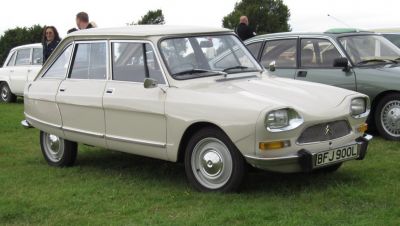 1958 Moskvich 407 Dimensions, Size & Specs
1958 Moskvich 407 Dimensions, Size & SpecsMeasurements of the 1958 Moskvich 407, engineered for optimal performance and comfort
| Dimensions | |
|---|---|
| Length: | 4055 mm159.6 in13.3 ft |
| Width: | 1540 mm60.6 in5.1 ft |
| Height: | 1560 mm61.4 in5.1 ft |
| Weight Specifications | |
| Curb Weight: | 910 kg2006 lbs |
| Maximal permitted Weight: | 1290 kg2844 lbs |
| Tire Specifications | |
| Rims Size: | 15-inch rims:
|
| Tire Size: |
|
The Moskvich 407, produced from 1958 to 1963, is a classic Soviet-era compact sedan recognized for its practical design and modest dimensions. With an overall length of 4055 mm (159.6 inches), width of 1540 mm (60.6 inches), and height of 1560 mm (61.4 inches), the Moskvich 407 occupies a moderate footprint, making it well-suited for urban and suburban driving environments typical of its production era.
Weighing in at a curb weight of 910 kg (2006 lbs) and a maximum weight of 1290 kg (2844 lbs), this vehicle balances a lightweight structure with sufficient robustness for passenger comfort and reliability. The sedan rides on 15-inch rims sized at 4.5K x 15, paired with 145/80 R15 tires providing a good balance between ride comfort and handling stability.
The Moskvich 407's design reflects the straightforward and functional automotive philosophy prevalent in the late 1950s Soviet Union, characterized by a clean body shape and practical dimensions. Its compact yet spacious profile offers efficient use of interior space while maintaining manageable exterior dimensions. This specification profile makes the Moskvich 407 an interesting model for enthusiasts and collectors looking to compare classic compact sedans and understand automotive design trends of that era.
Discover the standout features that make the 1958 Moskvich 407 a leader in its class
Have a question? Please check our knowledgebase first.
The Moskvich 407 sedan produced between 1958 and 1963 has a length of 4055 mm (approximately 159.6 inches), a width of 1540 mm (about 60.6 inches), and a height of 1560 mm (around 61.4 inches). These compact dimensions reflect the typical car sizing of Eastern European sedans from that era, designed for ease of maneuverability and urban use.
The curb weight of the Moskvich 407 is 910 kg (roughly 2006 lbs), which signifies the weight of the vehicle without passengers or cargo but with standard equipment and fuel. Its maximum permissible weight is 1290 kg (approximately 2844 lbs), indicating it can safely carry passengers and cargo within this limit. This weight range positions it as a lightweight, fuel-efficient vehicle for its time.
Yes, the Moskvich 407 fits comfortably into a standard residential garage. Standard garage dimensions in many regions typically measure about 2.4 to 2.7 meters wide (7.9 - 8.9 ft) and 5 to 6 meters deep (16.4 - 19.7 ft). Given the Moskvich 407's length of 4.055 meters and width of 1.54 meters, the car leaves plenty of clearance in a standard garage both in terms of width and length, making parking easy and convenient.
With a width of 1540 mm (60.6 inches), the Moskvich 407 is narrower compared to many Western sedans of the late 1950s, which often measured over 1700 mm (67 inches) wide. This narrower width reflects the smaller road infrastructure and urban design considerations in the Soviet Union at the time. It made the car more practical for tight city streets and easier to park but also meant slightly less interior shoulder room compared to Western counterparts.
The Moskvich 407 is equipped with rims sized 4.5K x 15 and tire sizes of 145/80 R15. This means the tires have a width of 145 mm, an aspect ratio of 80%, and fit on 15-inch diameter rims. These relatively narrow tires were typical for the period and suited the car’s modest power and weight, providing a balance between comfort and road-holding capabilities on the roads of its time.
The height of the Moskvich 407 is 1560 mm (61.4 inches), which makes it a fairly tall compact sedan. This height contributes positively to interior headroom, offering comfortable seating for passengers. The somewhat elevated profile was beneficial for visibility and ease of entry and exit, especially compared to lower rivals, without making the vehicle unwieldy or prone to stability issues.
Compared to its predecessor models Moskvich 400 and 401, the Moskvich 407 saw subtle size improvements while maintaining a similar compact footprint. The 407 retained a similar length and width but featured improvements in design and mechanics, aimed at better performance and passenger comfort. While dimensions did not dramatically increase, enhancements in build quality and engine technology made the 407 a more refined vehicle overall.
The Moskvich 407's compact dimensions, including its length of 4055 mm and narrow width of 1540 mm, set it apart as smaller and lighter than many Western compact sedans of the late 1950s, which often emphasized wider bodies and larger engines. The 407’s size was optimized for Soviet drivers’ needs, emphasizing simplicity, durability, and ease of repair. This contrasts with Western designs that sometimes prioritized larger, more spacious interiors and extra features.
Yes, the compact size and relatively light curb weight of 910 kg (2006 lbs) make the Moskvich 407 highly suitable for urban driving conditions. Its dimensions allow easy navigation through narrow city streets and tight parking spots common in city environments, especially during its production era. Additionally, the balance of weight and size aids fuel efficiency, beneficial for city driving with frequent stops and starts.
The Moskvich 407 was designed as a four-door sedan accommodating five passengers comfortably. Given its length of just over 4 meters and width of 1.54 meters, the interior space was modest but efficiently used. Rear bench seating allowed for three passengers, but the relatively narrow cabin limited shoulder room slightly. Height of 1560 mm ensured good headroom, making the car practical for family use and daily commuting.
Discover similar sized cars.

| Production: | 1956-1958 |
|---|---|
| Model Year: | 1956 |
| Length: | 4055 mm159.6 in |
| Width: | 1540 mm60.6 in |
| Height: | 1560 mm61.4 in |

| Production: | 1969-1973 |
|---|---|
| Model Year: | 1969 |
| Length: | 3990 mm157.1 in |
| Width: | 1520 mm59.8 in |
| Height: | 1485 mm58.5 in |

| Production: | 1973-1976 |
|---|---|
| Model Year: | 1973 |
| Length: | 3990 mm157.1 in |
| Width: | 1520 mm59.8 in |
| Height: | 1485 mm58.5 in |
